If your book is on Amazon, your primary goal will be to sell more books on Amazon. Selling books on Amazon is all about optimizing for the Amazon algorithm. Sound complicated? It can be, but don’t worry we have 5 easy-to-follow steps with detailed instructions that will help you make the most of the Amazon Algorithm.
The Amazon Algorithm Explained
Before we get into the steps, let’s explain the algorithm a little bit. The job of the Amazon algorithm is to best serve Amazon customers (aka readers) who are searching for something, AND to make relevant recommendations to Amazon customers on products they may like.
In order to do its job, the Amazon algorithm needs lots of data (called data inputs) about each product (which in your case is a book). The more data about your book the algorithm has, the more it will surface or recommend a product to a customer. When it comes to books, the primary inputs the Amazon algorithm looks for are: Keywords, genres, reviews, sales, downloads, sales rank, and browse activity. To optimize your book on Amazon, you need to optimize all these inputs for the algorithm. In this article we will show you how to do that so you can sell more books on Amazon. Now let’s get started!
1. Write a Comprehensive Book Description
Your book description is an important component in educating the Amazon algorithm (and human readers 😉 ) on what your book is about, and who will enjoy reading it. Below are the elements we recommend that every good book description has:
Accolades
If you or your book have won any awards or distinguishing titles (like bestseller), be sure to mention that in your book description. Anything and everything is worth mentioning. Now is NOT the time to be bashful about your accomplishments.
Comparables
Language that compares your title to best-selling authors and titles will let fans of those popular authors know that they should check your book out next. The basic construct is “if you like [famous book] then you’ll like [your book], but you’re a writer, mix it up a bit. Here’s an example from Sleeping Giants, where they use “In the tradition of…” to drop a few well-known books and authors into the description.
Emotional, gripping language
Be sure to use language that is evocative. Make readers feel something by simply reading your description, and leave them yearning for more. One strategy is to use the first few sentences from a particularly gripping scene in your book which tends to work well. However, don’t limit yourself, you can write evocative questions “Will she make it to the volcano in time?” or statements “Find out if Mike is truly her soulmate or if he has an alternate motive”, But don’t limit yourself to cliches; now is a good time to be creative.
Keywords for your genre
Different genres have different tropes that readers learn to look for. For example, in romance, HEA (happily ever after) stories are popular. If there are keywords that you know readers in your genre are going to be looking (and searching) for, be sure to include those in your description.One thing that you don’t want to do in your book description is to give away the plot. Don’t make it into a spoiler-filled trailer for your book. Instead, tease readers with just enough to make them curious.
2. Research your Categories and Keywords
Both categories and your keywords are important inputs to the algorithm and serve to help new readers discover your book when they are browsing Amazon. You set both your categories and your keywords in your Kindle Direct Publishing (KDP) account.
Let’s start with categories. On Amazon your categories are basically your genres, and you can only pick two for each book. When picking a category, be sure to pick the ones that most closely align with the content of your book. In Amazon’s own words:
“A browse category is the section of the Amazon site where users can find your book. Think of the browse category like the sections of a physical bookstore (fiction, history, and so on). You can select up to two browse categories for your book. Precise browse categorization helps readers find your book, so be sure to select the most appropriate categories for your book.”
Why is this important? Well, these categories are the basis for Amazon’s charts. You want the category to match the type of reader you are looking for. If you are writing a spy thriller, don’t pick romance as a category (even if there is a romantic element to your book) because readers browsing the Romance charts are not looking for spy thrillers. In order to see where your book will best fit in, peruse through the top charts for your potential categories, and see where your book would be the best fit. In the example below, we logged into our KDP account (kdp.amazon.com), selected the book we are working on (in our case a Non-Fiction Thanksgiving Cookbook), and scrolled down to the categories section. We then navigated down the categories and checked Seasonal and General under Cooking. This means that our book ranks first in those categories.
Next up: keywords. Optimizing your keywords is a fancy term for picking words you think people are going to search for. Imagine you are a reader, and you go to Amazon to find a book, what will you type in the search box? Get inside the mind of the reader and think about what words to add that will make your book easy to find. You will want to do two sets of research for keywords for your title.
First, you will want to research the main keywords that are associated with your book’s subject matter. These are the words that you will want to use in your title and on your book description page. Keywords that you use in your title will show up in the URL for your book, making it easier for your title to show up in searches for those words. In the example below, when a reader searches for Thriller, the algorithm knows that Hit for Hire is a possible result it can show the reader as Hit for Hire contains “thriller” in the URL, the title and the description.
To do this research, you can use the free functionality of KWFinder, or, if you’re running AdWords, Google’s keyword planner.
For example: Let’s say you’re writing a book on How to Make Dog Treats. When you search for related keywords, “Homemade Dog Treats” has almost 10 times the number of searches (aka Search Volume) that “How to Make Dog Treats” does. This means that you will want your title and book description to use the phrase “Homemade Dog Treats”.
Second, you will want to research the Amazon specific keywords that you will enter for your book. You get to choose just seven keywords for your title, so you want to choose them wisely. Dave Chesson over at Kindlepreneur has a fantastic step by step guide on how to research and select keywords that will allow Amazon to sell your book for you.
Amazon also has a useful resource on how to set keywords for your title, and they recommend focusing on five types of terms:
- Setting – for example, “1800’s France”.
- Character types – for example, “single dad” or “veteran”.
- Character roles – for example, “female sleuth”
- Plot themes – for example, “coming of age” or “family saga”
- Story tone – for example, “dystopian”
When your book is categorized under the correct genres and supplemented by the correct keywords, Amazon will do a better job of getting it in front of the right readers.
3. Get Reviews
We spoke above about how adding a review to your book description can help make your description more engaging to readers. More broadly, having many book reviews gives readers confidence in the quality of your work which will result in more readers purchasing your book. Book reviews are an important input to the algorithm, so this is another area where it’s worthwhile to focus. In our research, we found that the number of reviews is more important than the overall average review rating (as long as your average rating is over 3.5 stars). This means having 25 reviews with an average rating of 4.0 is better than having 5 reviews with an average rating of 5.0 stars. There are two key strategies for getting reviews for your titles:
Ask Your Readers
Do you have a mailing list? You should. If you don’t read our article about email marketing for authors. When your book comes out, email your readers and ask them to help you build reviews. Additionally, always include a link in the back of your book that asks readers to leave a review.
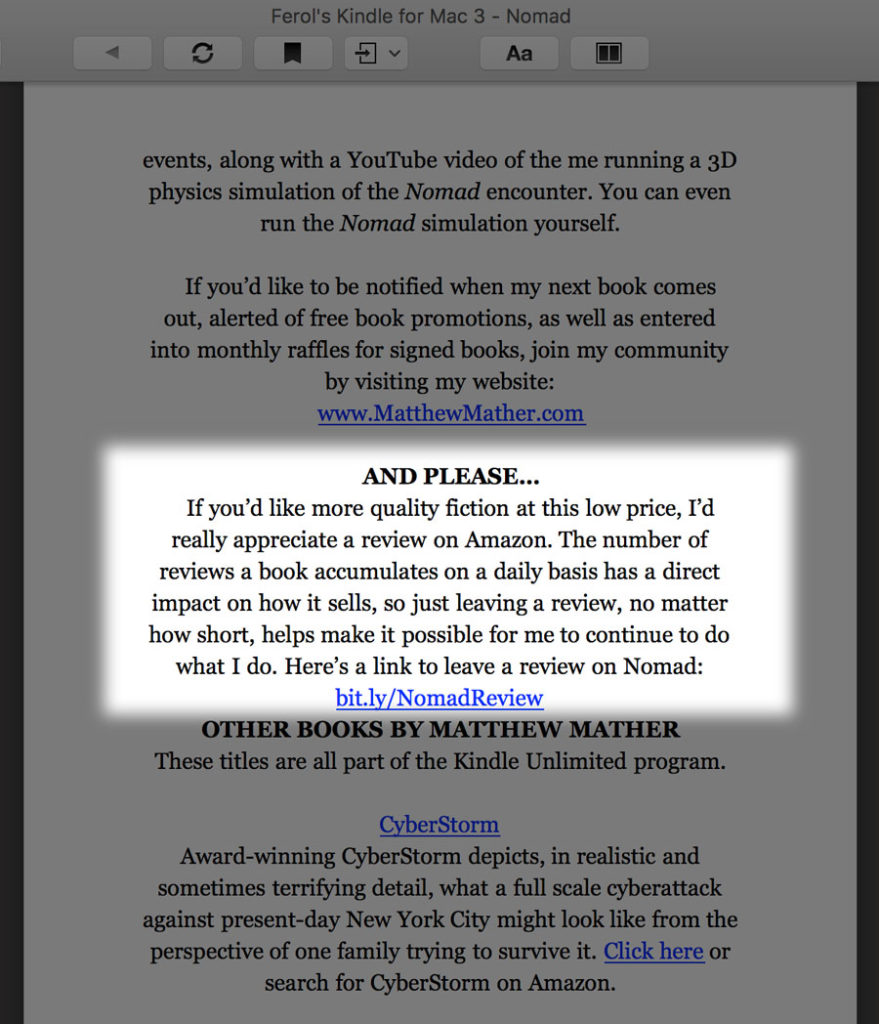
ARC (advance reader copy) Reviews
If you really want to make the most of reviews, try to get them before your book comes out on Amazon. How? Reach out to your most engaged readers and ask them to leave a review in return for an ARC. An ARC is a copy of the book you provide to readers BEFORE the book is actually published. This way, you are lining up reviews that can be posted to your Amazon book page on the day your book launches, and you don’t have to wait days, weeks, or even months, before gaining enough reviews to make a difference.
4. Update your Author Page
Once you have your book listing squared away with a good description, appropriate keywords, and favorable reviews, it’s time to take a look at your Author Page. Amazon gives authors the opportunity to set up a page that acts as a central location for all of their titles on Amazon. You can set up your author page through Author Central. The author page provides more valuable information to the algorithm: which readers follow your author page, which readers browse your author page, which other titles are in your catalog. On your author page you want to have:
A compelling biography
Tell your story in an engaging way. Why do you write? How long have you been at it? What is your inspiration? Do you have a pet, is it cute, and what is its name? These are all questions to which readers want to know the answer.
A professional author photo
It is worth getting professional headshots done so you can have a professional grade photo to feature around the web, It lets readers know that you take your writing, and the business of writing, seriously. Do a google search for local photographers in your area and plan on paying about $100 for a professional portrait. It may seem expensive, but it’s worth it.
All of Your Books
If you have all of your titles linked to your page, then it is much easier for readers who have found and enjoyed one of your titles, to find more!
Book Trailers or Other Promotional Videos
Amazon lets you link in all sorts of content. If you’ve paid to have a book trailer produced, be sure to feature it here.
Feed to Your Blog Posts
If you have a blog, be sure to sync it up with your author page. This way readers who discover you through Amazon can then discover your blog and all of its fun book news as they peruse your books on Amazon.
Follow Button
If readers are “following” you on Amazon, then they get an automated alert every time you publish a new book. That’s nifty.
Social Media and Website Information
Be sure to link to your other presences around the web so that readers can follow you there as well and see what all you’re up to!
Customize your URL
Make sure that your URL has your author name in it, so that your Amazon page shows up when people search for you on the web.
5. Drive Sales and Downloads of Your Book
The final step to sell more books on Amazon is to generate the data inputs for sales, downloads, and sales rank. To achieve this you will need to market and promote your book. The goal of promoting your book is to:
Drive sales of your book
Good marketing will help drive sales / KU borrows of your book, or free downloads if your book is free. The algorithm is more likely to recommend books that are being downloaded or purchased by readers.
Make your book start showing up in also-boughts
On every page on Amazon there is a section that says “customers who bought this also bought”. When you promote your title, your book will start showing up in this section on other book’s pages, increasing the numbers of readers who will discover your title. If you do not have enough readers browsing your page, then the algorithm won’t know which similar products to link with your book.
Make your book start showing up on the top charts
Amazon ranks the eBooks they sell according to popularity. When a title is downloaded by a large quantity of people, it will show up on the Amazon Best Seller chart. Many readers come to these charts to discover new books, so if you’re ranking here, you’ll be getting in front of plenty of new readers. Getting in front of new readers means that more people will buy your book, which means that ranking on the charts will help increase your sales rank, which is another input for the algorithm. You can wait for your book naturally to get on the Best Seller chart, but after working with thousands of authors, we’ve found concerted marketing is the best way to get on these charts.
At Written Word Media, we’re huge proponents of running price promotions. It’s one of the things we do best, and we know it works. We recommend running a price promotion and promoting your title to our large audiences of new readers. With over 600,000 readers across Freebooksy, Bargain Booksy, Red Feather Romance, and NewInBooks, running a promotion on one of our sites will be sure to get your title into the hands of readers.
Conclusion
It requires time and effort to optimize your Amazon presence. We understand that for authors, time not spent writing can be difficult to find. However, this is an investment worth making. Amazon is one of the most important places to sell your book, and if you follow these five steps you will have taken the first steps to sell more books on Amazon.
Update: Thanks to some great feedback from one of our authors, we’ve made updates to part 1 of this post. We removed the recommendation of having reviews/testimonials in the Book Description as this is prohibited by Amazon and we have removed a sentence about putting keywords in the description.

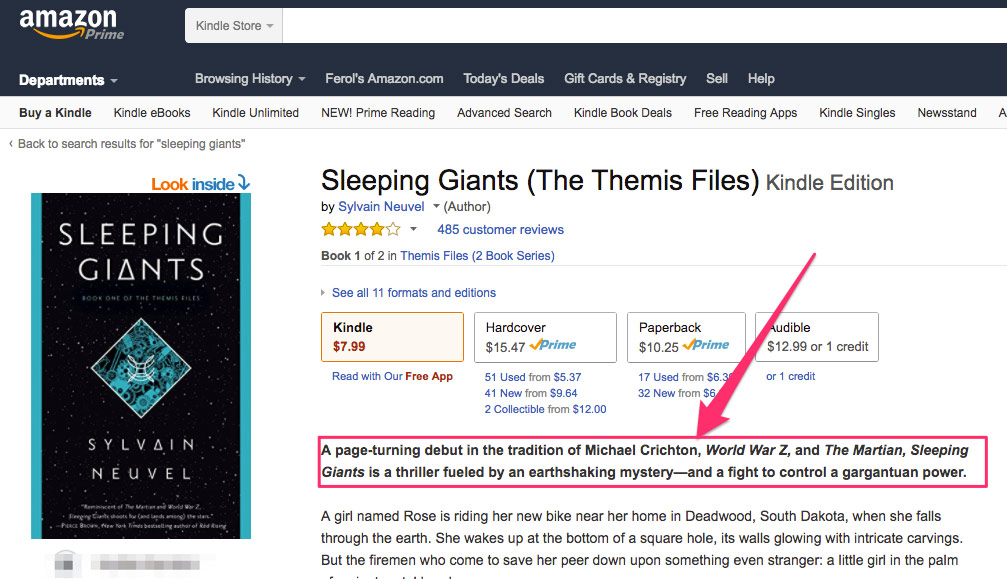
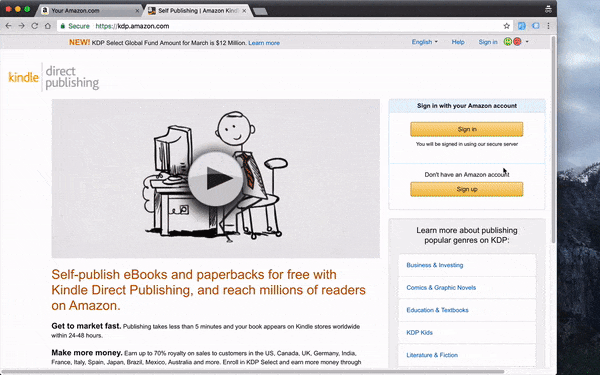
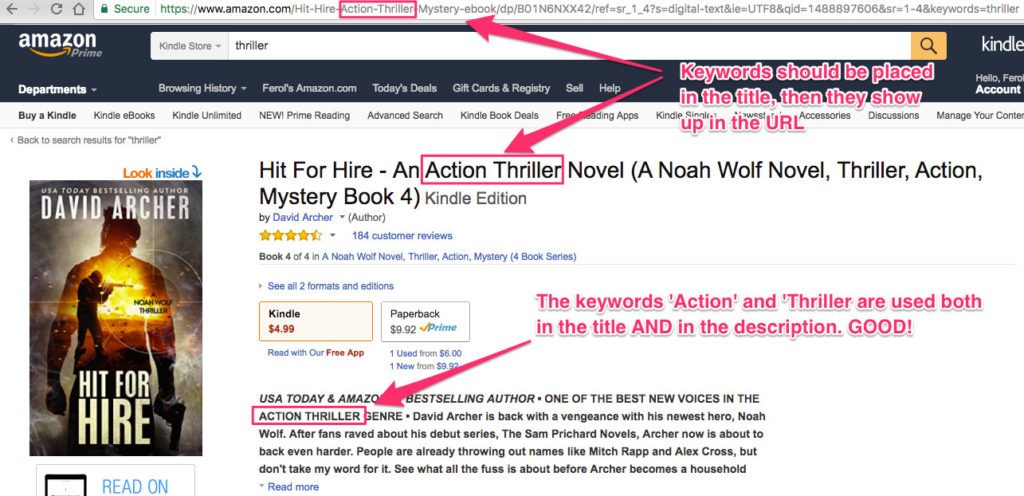
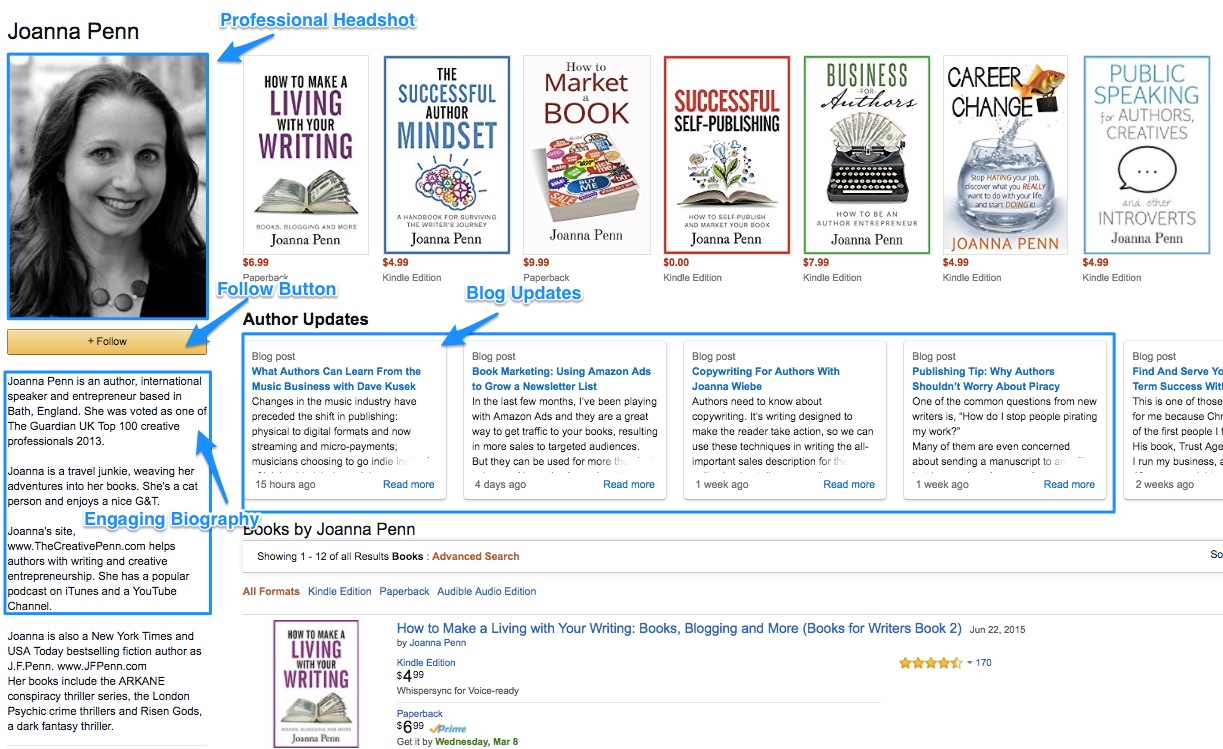

Any time I see something that says, “If you like X, you’ll like Y,” I am immediately turned off and won’t buy the product. I really don’t want the author to be compared to another author, because I think each author is an individual. It makes me insane when person unknown to me is telling me what I’ll like (or love) or not.
So, while that may indeed pull some people in, and I’m sure it does, that’s a surefire way to get me to move on.
Hi B.
Thanks for sharing your opinion! We hear from a lot of our readers that putting other best-selling authors in the descriptions of books helps them figure out whether or not they should give a novel a try. Obviously, that doesn’t work for everyone, though 🙂
It doesn’t work for me either. Also, don’t tell me I’ll stay up all night or can’t put the book down. Tell me what the story’s about!
I actually like it. When I’ve read everything that one author has written, seeing their name mentioned under another book will make me at least pause and read the description.
In the past I’ve googled “books like lions of lucerne” or “author similar to Nicholas Evans”.
I’m interested you give the M O’Keefe/J Kenner example of a review. If Amazon discovers a fellow author reviewing a book, they often take the review down. Even if it’s an author you’ve never met and live half a world away from. This is why authors mostly don’t review books. We’re sick of putting in the effort and having the reviews never show up. Ask me how I know!
Hi Kris,
In our experience, yes, Amazon can be strict when it comes to authors leaving starred “customer reviews” on other authors’ books. However, in this example the review isn’t a starred customer review, it’s only a part of the description, and thus acts as an accolade. It’s the eBook version of when quotes by other authors appear on the front and back covers of physical novels. As far as we know, Amazon doesn’t consider this in a negative manner, because it isn’t a customer review.
Authors are readers too. In fact, voracious readers. Why shouldn’t they be allowed to review a book? Not allowing them to review is a ridiculous Amazon rule. I may know a handful of other authors on a personal level. How could I possibly know every author of every book that I’ve read.
While I have seen many of these suggestions before, your examples really make the ideas “pop” in new ways. Thanks for great advice.
Super job, Chloe! More helpful than most of the marketing tip pieces I’ve seen. KJ
Thank You!
An interesting article but your advice “Try reaching out to an author friend who can review the book for you” to get more reviews will result in you having your reviews removed and possibly more. I have a fellow author who I met online as a result of her being a fan of my work. She then recommended my books to her friends. As a result her reviews are getting removed on Amazon.uk (and also one of her friends who they claimed I knew – I didn’t). But they won’t even allow readers to get to know authors whose work they like because they will say it is against Amazon rules. I am furious to lose precious genuine reviews this way and it doesn’t matter how to argue to with Amazon uk, they won’t budge.
Hi Kate,
I’m sorry to hear that! It must be terribly frustrating. We know that Amazon monitors customer reviews, the starred ones, quite closely, so getting authors to review your work in that way wasn’t what we were recommending. We are recommending that authors add positive reviews, whomever they may be from (Kirkus, a reader, another author), into the book description part of your Amazon listing. We have changed the language in the post to say “endorsement” instead of “review” in an attempt to avoid any further confusion! Thank you for your input 🙂
Thanks for clarifying, Chloe, and for making the distinction. Yes, it’s really frustrating, especially when I didn’t even ask the author to review my books, she just does, she reviews all books she likes. But having taken the trouble to get my books and review (they are all verified purchases), to have them removed is heart-breaking. At least Amazon.com are better than Amazon.uk (thus far) in that respect. This author and I just happen to love each other’s work. Interestingly, Amazon have left all my reviews up of her work. It annoys me no end though that Amazon doesn’t allow for this genuine passion for another author’s work.
Is this to say that I, as an author, cannot, or should not review Ernest Hemmingway, John Grisham, or even Dr. Zuess?
Reviewing books we read should be accepted on any level, or any standard. After all, an author is almost always a READER!
A couple of points:
1. Amazon doesn’t actually index the description field. So while a description is important for the reader who’s already reached your page, keyword stuffing the description does nothing to educate the algorithm about the book. Happy, though, to look at any evidence you have to support that it does.
2. Quotes/reviews/endorsements/testimonials are not permitted in descriptions under Amazon’s Metadata Guidelines. Those go in the Editorial Content field, which also isn’t indexed.
3. Amazon has been on a crackdown in the past couple of weeks around having the genre in the book’s title/subtitle, referring to those keywords as “extra descriptive content.” Even when those words are on the cover too. Some authors tend to take keyword-stuffing in the titles/subtitles to the extreme, and Amazon usually isn’t one to split hairs too finely.
Thanks for the feedback Phoenix. We’ve gone ahead and updated the article to reflect those points.
Great article that’s going to prove very useful. Many thanks.
Great article and thanks for the inclusion of my keyword article 😀
Begging for reviews is exhausting and humiliating. I don’t know why, but it was easier to get reviews 5 years years ago. Now every online transaction is asking for ratings and reviews (note netflix is changing from a star rating to a thumbs up/down model). I think people have become too busy to write even short comments. I can’t even get reviews from family members or from people who got the book for free . They will fb message me and say they liked the book, and some will post on fb that they liked the book, but they won’t post on amazon. I’d welcome any ideas on how to get people to actually act.
I am VERY new to all this. I don’t even know where to start I need some step by step guidance in this process.
Me too!
Feel very out of touch.
Children’s picture books in particular are very tricky and as I have already paid for illustrations they are costly too.
Sure i could have drawn a few pics myself but I went for the professional look.
Glad I did and just have to remind myself i write the books as I love sharing them.
I would just love to know how amazon works and how I can get it working for me!
Thanks for this information, and for other commenters’ input!
I’m an author and have been for most of my long life. AFAIK I’ve never had a review of mine removed when I praise or condemn another author’s work.
First let me say that I LOVE Freebooksy and Bargainbooksy. I was not aware of your other sites but I will check them out.
Just wanted to point out that Amazon does not allow you to have keywords in the title like this article recommends. The only thing they allow in the title and subtitle fields are title and subtitle as they appear on the book. As far as including other author’s books in the description, I’m not sure this would be allowed either. It is against the rules to include other books/authors in the keyword fields in KDP so I’m wondering about the logistics of using them in the description.
Thanks for the great advice, but Im still confused.My one and only book is a dramatically reformatted version of a public domain book. I have four reviews, one of which is from an English professor who is a published author. The others are from general readers. Can I use these reviews on a separate page in the book?
Thank you for the advice. I think reviews are the most useful in getting a book to sell, but this is also the hardest thing to obtain. I agree with another comment, that people just seem to busy to be bothered with leaving a review.
Thank you for your tremendous advice. Feel very out of touch.
Thank you for your worthwhile advice. I’m much more enlightened.
I am sure Ebay and amazon both will give you a step by step run down. If you couldn’t figure out how to look there, you shouldn’t be online let alone selling anything online
Incredible help in here. Thank you so much!
Thank you – very helpful to have all this advice in one place!
http://www.fenellaashworth.com
It can be a struggle keeping your head above water on Amazon; there are just too many books. With such a studs competition, you need all the tips you can get.
I actually like it when an author says something like “If you liked Ender’s Game, you’ll like this.” I’m always looking for more alien invasion or space fleet stories, and I’m not finding enough of those.
I’ve reviewed 160~ books so far and read 500-1000 books in my life (I’m in my 20s), and I finished writing my first book and I’m still not finding enough first contact stories that are to my liking, so having the comparison helps. It doesn’t guarantee I’ll like it, but at least Amazon lets me return a book if I don’t like it. And it helps that Amazon lets you download a sample of a book or take a look inside with the “look inside” feature.
It is great to read your article. I am an author of a newly published book on Amazon.
I got few insights about how Amazon algorithms work. Thanks.
I wonder why Amazon has made it so difficult for readers to review a book they have bought and read. Now, the reader should’ve made at least $50 worth of purchases on Amazon before they can leave a review on a book. When my book sells for far less, how do I get the buyer to leave a review?
Hey Martin, Yes it’s a common issue to have a hard time getting reviews on Amazon. You basically have to hope that your readers have purchased enough other items before your book that they are eligible to leave a review. It’s always a great idea to ask for reviews in your book’s back matter, and, if you have any email addresses of your readers, you can email to ask that they review your book.
I’ve read many similar suggestions before, but I’m not sure how effective optimisation really is. Does anyone have any experience either way?
Thanks a bunch for sharing this with all folks you really understand what you’re speaking about! Bookmarked. Please also talk over with my web site =). We may have a link change arrangement between us!
I’m a relatively new author—my debut novel was published on Amazon in Dec 2020—and I’m genuinely astounded at how difficult Amazon makes it to promote and sell our books on their site.
Logic should dictate that if we sell books, Amazon benefits as well as the writers. Isn’t that what their business is all about, after all? Selling our products?
I’m starting to suspect that the reason they make it so difficult is so that we’ll spend more on ads; that Amazon is primarily an advertising agency and the commissions are just cream to them. It seems the last thing they want is for us to sell without spending a small fortune on advertising.
Given the importance of sales on Amazon for driving your book up the ladder and given that the author should know his book better than anyone else, it is possible for the author in the short term to sell my books than Amazon.
Why does Amazon not give credit for sales made by the author? How can an author who buys 100 author copies and then sales them to people in his hometown get credit for 100 sales? Second, how do the people who buy those 100 books become verified purchasers?
Interesting! When anyone goes to the Amazon Forum and questions ‘why’ selling/marketing (their) books is so incredibly difficult, immediately those making money (largely from self-help books it seems) rise to the defense of Amazon self-publishing. Perhaps some of that defense is justified and the ‘advice to create a series and give away the first book in the series’ may be good advice. However, I am 83 years old and I don’t have time to create a series. My individual circumstances are of no difference to anyone….but, Amazon’s willingness (if not eagerness) to accept the ‘less than acceptable’ books, (perhaps knowing the writers of those books in utter futility ‘buy ads’) and make books readily available for free helping to defeat those of us who would like to (mindlessly) make a bit more in royalty than it costs to sell (ads) the book. So, it seems that simply writing a good book is the easy part. Marketing the book is the wall….and without extraordinarily good fortune…hitting it is inevitable. I believe that if Tom Sawyer’ was written today it would fall into the abyss of Amazon and disappear.
Well! I tried doing what was recommended for the description. I put in some words that reviewers used as accolades. Not an actual quote – just some exclamations. “Thought-provoking, well-written.” I then named some similar authors. “The variety of Gloria Naylor with a hint of Terri McMillan.” And I put this at the top. Book sales are down, so it seemed worth a try. Amazon just accepted my changes a few seconds ago. I’ll roll with it for a month and see what happens.